The competition season is hotting up, but are your plaits ‘hot to trot’?
At Renwick & Sons, we are perfectionists in every sense of the word, so here are our 7 steps to creating perfect plaits this season.
1. Be Prepared
Make sure your horse’s mane is an even thickness and length throughout before attempting to braid. An uneven thickness or variable length of hair will make your plaiting harder work. Make sure that you also have all the tools you need to hand before you get started. Make sure your horse’s mane is clean and if you do have to wash his mane, do this a few days before. Wash out all the shampoo and don’t use conditioner as this will make his mane slippery when you come to wet it to plait. You’ll need a brush such as our Mane & Tail T-Brush, a comb such as our Signature Comb, a wet sponge, needle and plaiting thread (nearest match to your horse’s hair colour) and elastic bands (again, the nearest match).
2. Stand Back
Take a few seconds to examine your horse’s neck conformation. Plaiting can enhance the neck and top line: if it is weak and needs more top-line, then a good trick is to position the plaits, so they sit on top of the neck, rather than flat to the neck, to give the illusion of more top line. If your horse has a big neck, you might want to aim the plaits to sit into the neck, below the top-line, so that they don’t add bulk. Playing around with the number and positioning of your plaits will ensure you make the most of your horse’s neck shape. Once you have decided on the number, brush through the hair thoroughly with our dual purpose T-Brush; Using the comb head first, then bristle side, alternating as you go, to ensure the mane is entirely tangle-free and doesn’t have any hidden mud or shavings within.
3. Odd Or Even?
Dampen the hair down with the sponge and comb the hair down flat again with the comb. Turn the comb on its side and section the hair off into ‘bunches’. Traditionally the total number of braids are kept to even numbers (including the forelock) and securing the bunches with elastic bands is an excellent way to correctly space them out and help you plan how many to create. Once plaited and the ends are secured with elastic bands (or if you are really professional with thread) you’ll want to sew the plaits.
4. Sew Me The Way
Sewing the plaits ensures a very professional look for the show ring, although elastic bands are acceptable at lower levels. Expertly sewn braids do tend to be more secure than elastic band versions, and you also have the advantage of being able to create a more uniformed look using a needle and thread.
5. Stitch & Go
Securing the thread at the end of the plait, fold it back under itself and then push the needle up from underneath at the top of the braid and back down the middle inside the folded braid to the bottom. Push the needle through the end, then back up to the top and gently pull the needle through. As you start to pull the needle, you will see your plait starts to curl. Gently guide it into place between your finger and thumb, you can manoeuvre it to sit precisely in place on the horse’s neck. Stitch front to back and into place, ensuring that the thread is not visible.
6. Ready For Anything
Make sure you pack your entire plaiting kit, in the rare event of an emergency tidy up when you get to your show. Some horses are very good at rubbing out plaits in the lorry, no matter how expertly sewed in! You may also have time after your classes to remove them before boxing up and heading back home. Many professionals keep a cotton un-picker in their plaiting kit so as not to damage the hair by accidentally cutting it with scissors. If you have a busy season ahead, you might want to look at getting one!.
7. Nice & Easy
Take care when brushing out the plaits. Carefully tease out the thread and any elastic bands with your fingers and unplait each plait before running a brush gently through, followed by a final comb through if needs be.
Good luck with your shows!
If you enjoyed reading this blog, you may enjoy The Equestrian’s Top Time-Saving Tips.
Back to Journal
